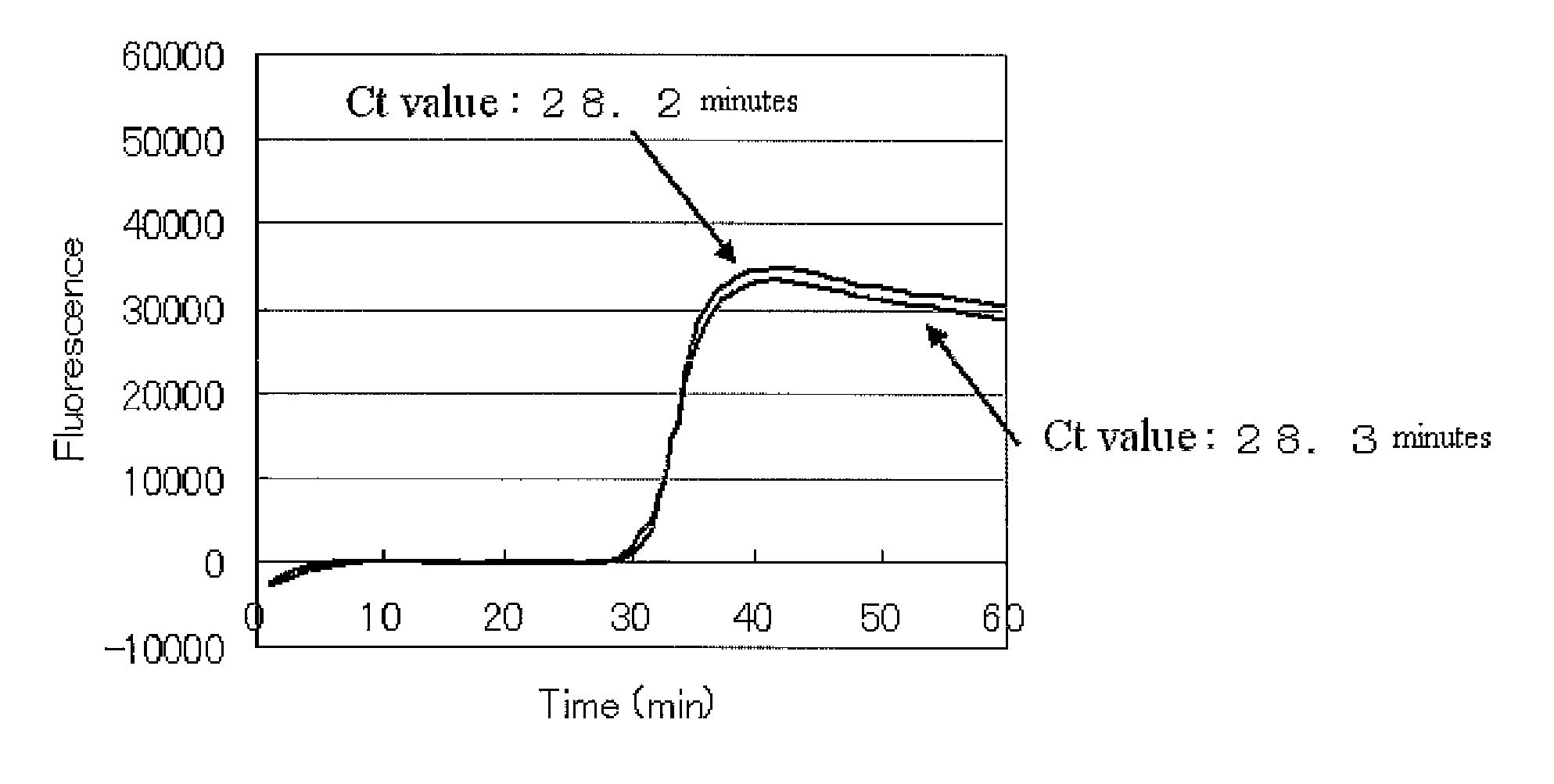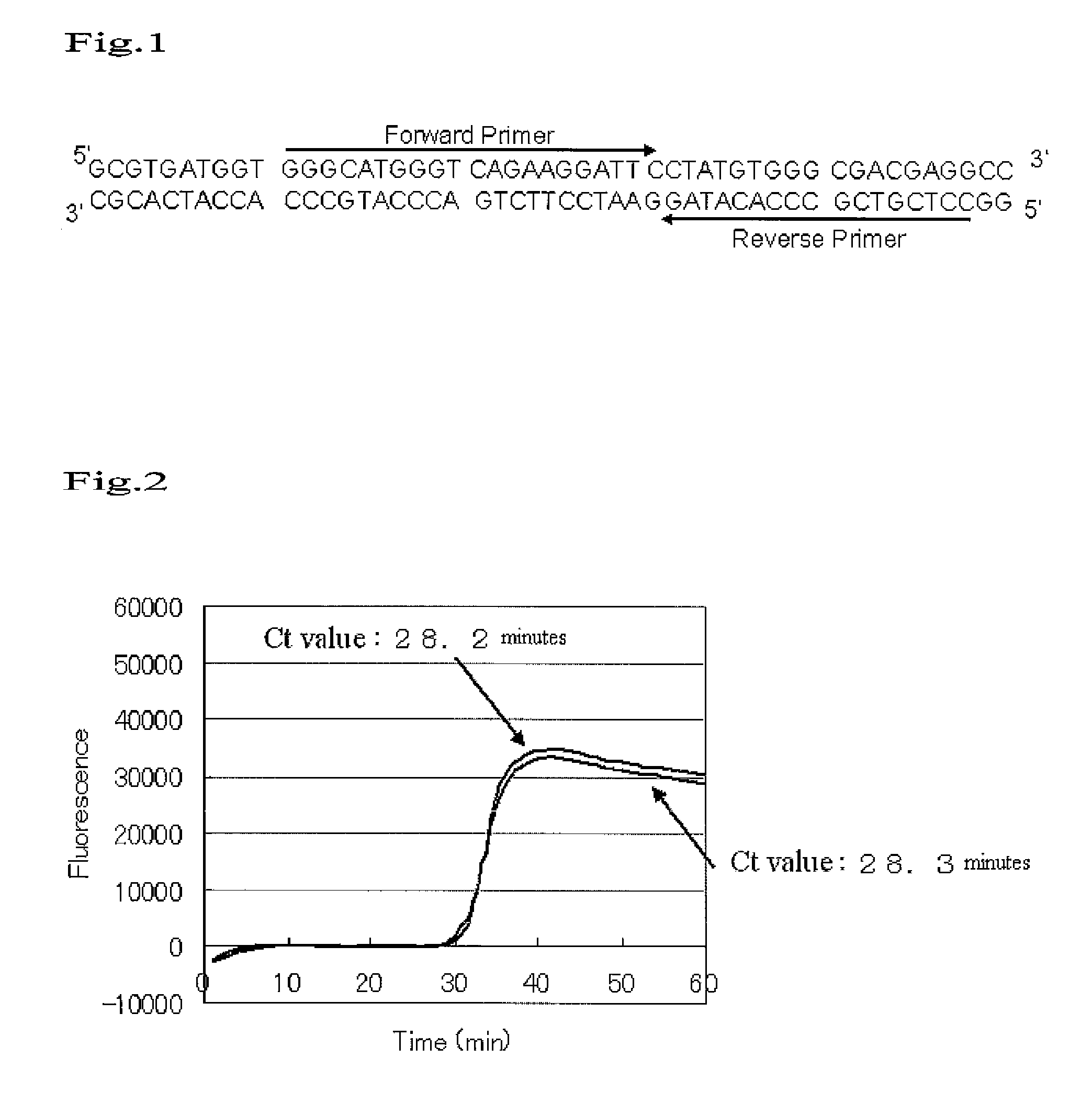RNA detection method
a detection method and rna technology, applied in the field of rna detection methods, can solve the problems of complex temperature control, high cost, and high cost, and achieve the effects of low risk of contamination, convenient and rapid manner, and efficient amplification within a short tim
- Summary
- Abstract
- Description
- Claims
- Application Information
AI Technical Summary
Benefits of technology
Problems solved by technology
Method used
Image
Examples
example 1
Detection of β-Actin mRNA in Total RNA
(1) Production of DNA Complementary to Template RNA by Reverse Transcription Reaction
[0073]Pure water was added to Human Liver Total RNA (0.1 μg, Clonetech), Random 6mer Primer (100 pmol, TaKaRa), and dNTP Mixture (10 nmol) to a final volume of 13 μl, followed by heating at 65-C for 5 minutes.
[0074]A 5-fold-concentrated reverse transcription buffer (4 μl) and 100 mM dithiothreitol (2 μl) were added to the reaction solution, followed by heating at 42° C. for 2 minutes.
[0075]SuperScript II (1 μl, invitrogen) was added to the reaction solution, followed by heating at 25° C. for 10 minutes, 42° C. for 50 minutes, and 70° C. for 10 minutes.
(2) Nucleic Acid Amplification Reaction with the Use of DNA Produced in (1) as a Template
[0076]The following primers were used to carry out sequence-specific nucleic acid amplification.
[0077]Primers were designed using the reverse transcribed DNA (and its complementary sequence) of β-actin mRNA as a target. Each pr...
example 2
RNA Detection in a Single Reaction Vessel
(1) Reverse Transcription Reaction and Nucleic Acid Amplification Reaction
[0082]Human Liver Total RNA (0.1 μg, Clonetech) was used as a template RNA.
[0083]The following primers were used to carry out sequence-specific nucleic acid amplification.
[0084]Primers were designed using the reverse transcribed DNA (and its complementary sequence) of β-actin RNA as a target. Each primer sequence is as shown below.
Primer (1) (Forward):5′-GGGCATGGGTCAGAAGGATT-3′(SEQ ID NO: 1)Primer (2) (Reverse):5′-CCTCGTCGCCCACATAG-3′(SEQ ID NO: 2)
[0085]The amplification reaction was performed with the composition of a reaction solution shown below at 25° C. for 10 minutes, 42° C. for 50 minutes, and 60° C. for 60 minutes. Bst. DNA polymerase (NEB (New England Biolabs)) was used as an enzyme.
Template RNA (0.1 μg / μL)1.0μLRandom 6mer Primer (100 μM)1.0μLDithiothreitol (0.1 μM)2.0μL10 × Bst Buffer2.5μLMgSO4 (100 mM)1.5μLTween20 (10% (v / v))0.25μLDMSO1.25μLdNTP (25 mM each)1...
PUM
| Property | Measurement | Unit |
|---|---|---|
| Temperature | aaaaa | aaaaa |
| Fraction | aaaaa | aaaaa |
| Melting point | aaaaa | aaaaa |
Abstract
Description
Claims
Application Information
 Login to View More
Login to View More - R&D
- Intellectual Property
- Life Sciences
- Materials
- Tech Scout
- Unparalleled Data Quality
- Higher Quality Content
- 60% Fewer Hallucinations
Browse by: Latest US Patents, China's latest patents, Technical Efficacy Thesaurus, Application Domain, Technology Topic, Popular Technical Reports.
© 2025 PatSnap. All rights reserved.Legal|Privacy policy|Modern Slavery Act Transparency Statement|Sitemap|About US| Contact US: help@patsnap.com



